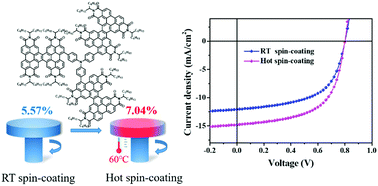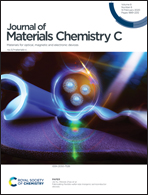A perylene diimide electron acceptor with a triphenylamine core: promoting photovoltaic performance via hot spin-coating†
Abstract
Perylene diimide (PDI) oligomers, in which the PDI panels were fused together by ethylene bridges, have emerged as potential alternatives to the parent PDI in organic optoelectronic materials. Meanwhile, triphenylamine (TPA), owing to its facile synthesis, flexible modification, excellent electron donating capability and twisted molecular structure, is commonly employed as the congested core to construct star-shaped electron acceptors and donors for organic solar cells (OSCs). In this contribution, a TPA-cored helical perylene diimide oligomer (PDI2) electron acceptor, namely TPA-3PDI2, was designed and synthesized. Using the commercially available PTB7-Th as an electron donor, a power conversion efficiency (PCE) of 5.57% was obtained for the room temperature (RT) spin-coating blend based OSCs. Interestingly, the hot spin-coating blend based OSCs showed a higher PCE of 7.04%. The results demonstrate that using PDI2 as a building block to construct star-shaped acceptors is a facile strategy to achieve considerable PCEs in OSCs and also, hot spin-coating is a feasible method for morphology optimization.



 Please wait while we load your content...
Please wait while we load your content...